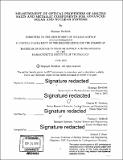| dc.contributor.advisor | Charles W. Forsberg and Thomas J. McKrell. | en_US |
| dc.contributor.author | Berdibek, Shapagat | en_US |
| dc.contributor.other | Massachusetts Institute of Technology. Department of Nuclear Science and Engineering. | en_US |
| dc.date.accessioned | 2017-01-30T19:17:31Z | |
| dc.date.available | 2017-01-30T19:17:31Z | |
| dc.date.issued | 2015 | en_US |
| dc.identifier.uri | http://hdl.handle.net/1721.1/106769 | |
| dc.description | Thesis: S.B., Massachusetts Institute of Technology, Department of Nuclear Science and Engineering, 2015. | en_US |
| dc.description | "June 2015." Cataloged from PDF version of thesis. | en_US |
| dc.description | Includes bibliographical references (page 29). | en_US |
| dc.description.abstract | Renewable energies can reduce the dependence on fossil fuels. Solar thermal systems designed to use molten salts to directly absorb the solar heat are promising due to (1) potentially higher efficiency in capture of sunlight and (2) use of the salt to simultaneously capture sunlight and store heat in the salt. The optical properties of the molten salts are crucial for the design of such thermal systems because they determine the depth of the salt required to absorb sunlight and allow modeling of the performance of such systems. Molten salts are also being developed as coolants for high temperature reactors. Optical properties are also required to determine the radiative heat transfer of the coolant. The objectives of this thesis were to build a better system to measure these properties and measure the optical properties of the proposed salt for a direct absorption concentrated solar thermal system. The attenuation coefficient of light in a binary nitrate salt mixture (KNO 3-NaNO3 40-60 wt%) was measured over the wavelength range 833-2500 nm and the temperature range 300-400°C. This salt is the leading candidate for the first generation of a proposed concentrated solar power on demand (CSPonD) concept [3]. The relevant data was obtained using a FTIR spectrometer and an experimental apparatus designed for semitransparent liquids. The apparatus was validated using the published data for the attenuation of light in deionized water. The attenuation coefficients of the binary nitrate salt mixture for the lower wavelengths matched the data obtained by Passerini [1]. For the longer wavelengths, the attenuation coefficient peaked around 2.5 Pm as predicted by Drotning [2]. Since certain metallic components of solar and nuclear systems are exposed to the molten salt, it is important to characterize the behavior of their reflectivity in the presence of the molten salt. The reflectivity of 304L stainless steel was measured for the wavelength range 600-5000 nm at incident angles of light 10°, 40°, and 70° after an 8-day molten salt immersion test. The reflectivity was measured to be less than 10% for the solar spectrum. | en_US |
| dc.description.statementofresponsibility | by Shapagat Berdibek. | en_US |
| dc.format.extent | 32 pages | en_US |
| dc.language.iso | eng | en_US |
| dc.publisher | Massachusetts Institute of Technology | en_US |
| dc.rights | MIT theses are protected by copyright. They may be viewed, downloaded, or printed from this source but further reproduction or distribution in any format is prohibited without written permission. | en_US |
| dc.rights.uri | http://dspace.mit.edu/handle/1721.1/7582 | en_US |
| dc.subject | Nuclear Science and Engineering. | en_US |
| dc.title | Measurement of optical properties of molten salts and metallic compounds for advanced solar and nuclear systems | en_US |
| dc.title.alternative | Measurement of optical properties of molten salts for advanced solar and nuclear systems | en_US |
| dc.type | Thesis | en_US |
| dc.description.degree | S.B. | en_US |
| dc.contributor.department | Massachusetts Institute of Technology. Department of Nuclear Science and Engineering | |
| dc.identifier.oclc | 969778918 | en_US |
